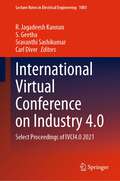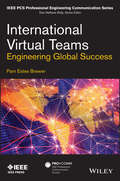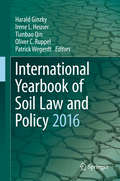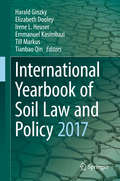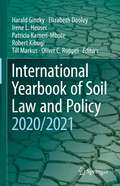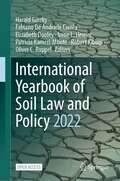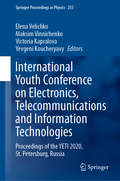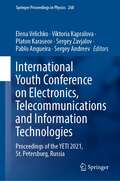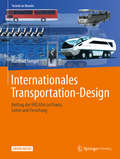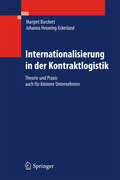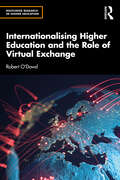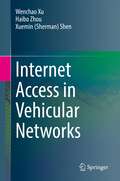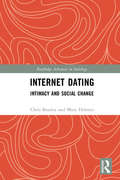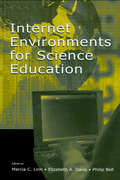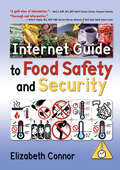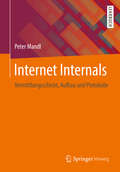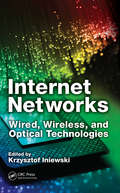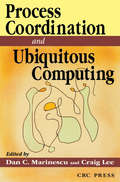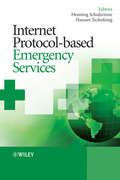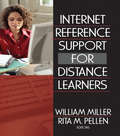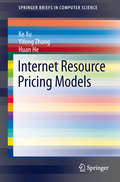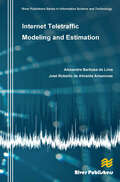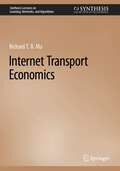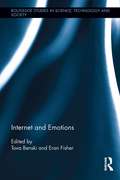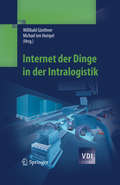- Table View
- List View
International Virtual Conference on Industry 4.0: Select Proceedings of IVCI4.0 2021 (Lecture Notes in Electrical Engineering #1003)
by S. Geetha R. Jagadeesh Kannan Sravanthi Sashikumar Carl DiverThis book presents the proceedings of the International Virtual Conference on Industry 4.0 (IVCI4.0 2021). This conference brings together specialists from the academia and industry sectors to promote the exchange of knowledge, ideas, and information on the latest developments and applied technologies in the field of Industry 4.0. The book discusses a wide range of topics such as safe and affordable housing, affordable and sustainable transport systems, mitigating adverse effects on natural disasters, mitigating environmental impact, green and public spaces, sustainable and resilient building, sustainable urbanization, and cultural and natural heritage conservation. The book supports the transfer of vital knowledge to the next generation of academics and practitioners.
International Virtual Teams: Engineering Global Success
by Pam Estes BrewerDr. Brewer presents a complete guide to international virtual team communication with the most up-to-date research developments in the engineering workplace on a global scale, and a problem-solving approach to using and communicating in virtual teams. Presents guidelines heavily based on empirical data Application of virtual team communication guidelines to the field of engineering Provides strategies and sample projects for teaching
International Yearbook of Soil Law and Policy 2016
by Harald Ginzky Irene L. Heuser Tianbao Qin Oliver C. Ruppel Patrick WegerdtThe first volume of the International Yearbook of Soil Law and Policy includes an important discussion on the implementation of the Sustainable Development Goals that are the basis for the post-2015 development agenda up to the year 2030; the Yearbook focuses in particular on Goal 15, which includes achieving a "land degradation-neutral world. " It also provides a comprehensive and highly informative overview of the latest developments at the international level, important cross-disciplinary issues and different approaches in national legislation. The book is divided into four sections. Forewords by internationally renowned academics and politicians are followed by an analysis of the content and structure of the Sustainable Development Goals with regard to soil and land as well as the scientific methods for their implementation. In addition, all relevant international regimes are discussed, including the latest developments, such as the decisions made at the 12th Conference of the Parties to the United Nations Convention to Combat Desertification (UNCCD) and the Paris Agreement on Climate Change. The next section deals with cross-disciplinary issues relevant to the implementation of the Sustainable Development Goals like the right to food, land tenure, migration and the "Economics of Land Degradation" initiative. The last section gathers reports on the development of national legislation from various nations and supra-national entities, including Brazil, China, the European Union, Mongolia, Namibia and the United States. Addressing this broad range of key topics, the book offers an indispensible tool for all academics, legislators and policymakers working in this field. The "International Yearbook of Soil Law and Policy" is a book series that discusses the central questions of law and politics with regard to the protection and sustainable management of soil and land - at the international, national and regional level.
International Yearbook of Soil Law and Policy 2017 (International Yearbook of Soil Law and Policy #2017)
by Harald Ginzky Irene L. Heuser Tianbao Qin Elizabeth Dooley Emmanuel Kasimbazi Till MarkusThis book presents an important discussion on soil and sustainable agriculture from a range of perspectives, addressing key topics such as sustainable intensification, the FAO Voluntary Guidelines, and the crucial role of appropriate tenure rights. This second volume of the International Yearbook of Soil Law and Policy is divided into four parts, the first of which deals with several aspects of the theme "soil and sustainable agriculture. " In turn, the second part covers recent international developments, the third part presents regional and national reports, and the fourth discusses cross-cutting issues. Given the range of key topics covered, the book offers an indispensible tool for all academics, legislators and policymakers working in this field. The "International Yearbook of Soil Law and Policy" is a book series that discusses central questions in law and politics with regard to the protection and sustainable management of soil and land - at the international, national and regional level. The Chapter "The Use of Property Law Tools for Soil Protection" by Jessica Owley is available open access under a CC BY 4. 0 license at link. springer. com.
International Yearbook of Soil Law and Policy 2020/2021 (International Yearbook of Soil Law and Policy #2020)
by Harald Ginzky Irene L. Heuser Oliver C. Ruppel Elizabeth Dooley Till Markus Robert Kibugi Patricia Kameri-MboteThis book presents an important discussion on land tenure rights for the effective implementation of sustainable soil management provisions. It investigates a variety of aspects, such as the clash of modern and traditional tenure concepts, forms of illegal or illegitimate land acquisition, and the preconditions for legal and legitimate investments. In addition, the book analyses the challenges to ensuring secure land tenure rights in Africa and in Germany. Lastly, it provides information on the role of women in this context.This fifth volume of the International Yearbook of Soil Law and Policy is divided into four parts, the first of which deals with various aspects of the theme “Land Tenure Rights and Sustainable Soil Management”. The second part covers recent international developments, the third part presents regional and national reports, and the fourth discusses overarching issues. Given the range of key topics covered, the book offers an indispensable tool for all academics, legislators and policymakers working in this field.The “International Yearbook of Soil Law and Policy” series discusses central questions in law and politics with regard to the protection and sustainable management of soil and land – at the international, national, and regional level.
International Yearbook of Soil Law and Policy 2022 (International Yearbook of Soil Law and Policy #2022)
by Harald Ginzky Irene L. Heuser Oliver C. Ruppel Elizabeth Dooley Robert Kibugi Patricia Kameri-Mbote Fabiano De Andrade CorrêaThis open access book presents an important discussion on the interface between sustainable soil management and climate mitigation and adaptation. It investigates a variety of aspects in this context, such as the political and societal consequences for countries in the Global South, an assessment of the outcomes of the UNFCCC Conference of Parties held in Glasgow, appropriate legal instruments to promote desealing, regulatory concepts for negative emissions in soil and land use, the debate in Europe on carbon uptake in soils and the climate-related policy of the Convention on Biological Diversity. Lastly, it provides information on recent court rulings on climate mitigation in Germany and Australia and their relevance for sustainable soil management.This sixth volume of the International Yearbook of Soil Law and Policy is divided into four parts, the first of which deals with various aspects of the theme “Climate Mitigation and Adaptation and Sustainable Soil Management.”The second part covers recent international developments, the third presents regional and national reports, and the fourth discusses overarching issues. Given the range of key topics covered, the book offers an indispensable tool for all academics, legislators and policymakers working in this field. The “International Yearbook of Soil Law and Policy” series discusses central questions in law and politics with regard to the protection and sustainable management of soil and land – at the international, national, and regional level.
International Youth Conference on Electronics, Telecommunications and Information Technologies: Proceedings of the YETI 2020, St. Petersburg, Russia (Springer Proceedings in Physics #255)
by Yevgeni Koucheryavy Elena Velichko Maksim Vinnichenko Victoria KapralovaThis volume presents peer reviewed and selected papers of the International Youth Conference on Electronics, Telecommunications and Information Technologies (YETI-2020), held in Peter the Great St. Petersburg Polytechnic University, St. Petersburg on July 10–11, 2020. It discusses current trends and major advances in electronics, telecommunications, optical and information technologies, focusing, in particular, on theoretical and practical aspects of developing novel devices and materials, improving data processing methods and technologies. The conference brings together young researchers and early-career scientists participating in a series of lectures and presentations, establishing contacts with potential partners, sharing new project ideas and starting new collaborations.
International Youth Conference on Electronics, Telecommunications and Information Technologies: Proceedings of the YETI 2021, St. Petersburg, Russia (Springer Proceedings in Physics #268)
by Pablo Angueira Sergey Andreev Elena Velichko Viktoria Kapralova Platon Karaseov Sergey ZavjalovThis book presents peer-reviewed and selected papers of the International Youth Conference on Electronics, Telecommunications, and Information Technologies (YETI-2021), held in Peter the Great St. Petersburg Polytechnic University, St. Petersburg, on April 22–23, 2021. For the third time around, the conference brings together students and early career scientists, serving to disseminate the current trends and advances in electronics, telecommunications, optical, and information technologies. A series of workshops and poster sessions focusing, in particular, on the theoretical and practical challenges in nanotechnologies, photonics, signal processing, and telecommunications allow to establish contacts between potential partners, share new ideas, and start new collaborations. The conference is held in an online format, thus considerably expanding its geographical reach and offering an even wider scope of discussion.
Internationales Transportation-Design: Beitrag der HfG Ulm zu Praxis, Lehre und Forschung (Technik im Wandel)
by Hartmut SeegerDas Entwickeln von Fahrzeugen aller Art ist heute eine eigenständige Wissensdisziplin, die in ihrem gesamten Umfang mit digitalen Tools bearbeitet wird. Die diesbezüglichen Teilaufgaben, wie z.B. die Maßkonzeption von Fahrzeugen, entstanden aber alle in der vorausgehenden Phase in der handwerklichen Tradition sowie durch die Orientierung am sogenannten Funktionalismus und an den neuen Designwissenschaften, wie z.B. der Ergonomie. Das vorliegende Werk behandelt diese 100jährige Entwicklung am Beispiel der diesbezüglichen Pionierinstitution, der Hochschule für Gestaltung Ulm (1953-1968) und der Arbeit ihrer Alumnis bis in die Gegenwart.Die zentrale Information dieses Werkes betrifft diese interessante Wechselwirkung und Entwicklungslinie vom Kinderwagen bis zur Weltraumstation und von den Zeichentechniken bis zur designbezogenen Semantik und interfaceorientierten Pragmatik.
Internationalisierung in der Kontraktlogistik
by Margret Borchert Johanna Heuwing-EckerlandAuf dem Gebiet der Kontraktlogistik besteht eine große Diskrepanz zwischen betrieblicher Praxis und wissenschaftlichem Diskurs. Die Autoren arbeiten das Themenfeld anhand von Theorien des Internationalisierungsprozesses und empirischen Untersuchungen wissenschaftlich auf und konzentrieren sich dabei auf kleine und mittlere Unternehmen. Die Ergebnisse wurden in einem praxisorientierten, Leitfaden leicht verständlich aufbereitet - mit einem Überblick über Methoden, mit Checklisten, weiterführender Literatur sowie relevanten Internetlinks.
Internationalising Higher Education and the Role of Virtual Exchange (Routledge Research in Higher Education)
by Robert O'DowdThis volume introduces Virtual Exchange (VE) as an innovative form of online intercultural learning and investigates the myriad of ways VE is being carried out across universities, ultimately arguing for its integration into university internationalisation policies and course curricula. Against the backdrop of increased digitalisation initiatives throughout universities given the effects of the pandemic, chapters focus not only on providing new research findings, but also on providing a comprehensive introduction and argumentation for the use of VE in university education and also in demonstrating how it can be put into use by both university decision-makers and educators. Reviewing the limitations of the activity, this timely work also fundamentally posits how VE and blended mobility more broadly could be developed in future higher education initiatives. This book will be of interest to researchers, academics, scholars, and students involved with Open & Distance Education and eLearning, approaches to internationalisation in education, and the study of higher education more broadly. Those interested in innovative methods for teaching and learning, as well as educational research, will also benefit from this volume.
Internet Access in Vehicular Networks
by Haibo Zhou Xuemin (Sherman) Shen Wenchao XuThis book introduces the Internet access for vehicles as well as novel communication and computing paradigms based on the Internet of vehicles. To enable efficient and reliable Internet connection for mobile vehicle users, this book first introduces analytical modelling methods for the practical vehicle-to-roadside (V2R) Internet access procedure, and employ the interworking of V2R and vehicle-to-vehicle (V2V) to improve the network performance for a variety of automotive applications. In addition, the wireless link performance between a vehicle and an Internet access station is investigated, and a machine learning based algorithm is proposed to improve the link throughout by selecting an efficient modulation and coding scheme.This book also investigates the distributed machine learning algorithms over the Internet access of vehicles. A novel broadcasting scheme is designed to intelligently adjust the training users that are involved in the iteration rounds for an asynchronous federated learning scheme, which is shown to greatly improve the training efficiency. This book conducts the fully asynchronous machine learning evaluations among vehicle users that can utilize the opportunistic V2R communication to train machine learning models. Researchers and advanced-level students who focus on vehicular networks, industrial entities for internet of vehicles providers, government agencies target on transportation system and road management will find this book useful as reference. Network device manufacturers and network operators will also want to purchase this book.
Internet Dating: Intimacy and Social Change (Routledge Advances in Sociology)
by Chris Beasley Mary HolmesInternet Dating deals primarily with the experiences of UK and Australian daters, examining their online accounts to see what kinds of narratives, norms, emotions and ‘chemistry’ shape their dating. Has the emergence and growth of internet dating changed the dating landscape for the better? Most commentators, popular and academic, ask whether online dating is more efficient for individuals than offline dating. We prefer a socio-political perspective. In particular, the book illustrates the extent to which internet dating can advance gender and sexual equality. Drawing on the voices of internet daters themselves, we show that internet dating reveals how social change often arises in the unassuming, everyday and familiar. We also pay attention to often ignored older daters and include consideration of daters in Africa, Scandinavia, South America, Asia and the Middle East. Throughout, we explore the pitfalls and pleasures of men and women daters navigating unconventional directions towards more equitable social relations.
Internet Environments for Science Education
by Marcia C. LinnInternet Environments for Science Education synthesizes 25 years of research to identify effective, technology-enhanced ways to convert students into lifelong science learners--one inquiry project at a time. It offers design principles for development of innovations; features tested, customizable inquiry projects that students, teachers, and professional developers can enact and refine; and introduces new methods and assessments to investigate the impact of technology on inquiry learning. The methodology--design-based research studies--enables investigators to capture the impact of innovations in the complex, inertia-laden educational enterprise and to use these findings to improve the innovation. The approach--technology-enhanced inquiry--takes advantage of global, networked information resources, sociocognitive research, and advances in technology combined in responsive learning environments. Internet Environments for Science Education advocates leveraging inquiry and technology to reform the full spectrum of science education activities--including instruction, curriculum, policy, professional development, and assessment. The book offers: *the knowledge integration perspective on learning, featuring the interpretive, cultural, and deliberate natures of the learner; *the scaffolded knowledge integration framework on instruction summarized in meta-principles and pragmatic principles for design of inquiry instruction; *a series of learning environments, including the Computer as Learning Partner (CLP), the Knowledge Integration Environment (KIE), and the Web-based Inquiry Science Environment (WISE) that designers can use to create new inquiry projects, customize existing projects, or inspire thinking about other learning environments; *curriculum design patterns for inquiry projects describing activity sequences to promote critique, debate, design, and investigation in science; *a partnership model establishing activity structures for teachers, pedagogical researchers, discipline experts, and technologists to jointly design and refine inquiry instruction; *a professional development model involving mentoring by an expert teacher; *projects about contemporary controversy enabling students to explore the nature of science; *a customization process guiding teachers to adapt inquiry projects to their own students, geographical characteristics, curriculum framework, and personal goals; and *a Web site providing additional links, resources, and community tools at www.InternetScienceEducation.org
Internet Guide to Food Safety and Security
by Elizabeth ConnorLearn what you need to know about foodborne illness—from comprehensive Web sites! The Internet Guide to Food Safety and Security puts a wealth of food safety and security information at your fingertips. This comprehensive compilation of annotated links goes beyond simple listing of Web addresses to tell you which sites have original content, what sites hold specific safety and security information you are searching for, and how to find all types of vital information you need to prevent foodborne illness and disease to stay healthy. Easy-to-use, thorough, and accurate, this guide to the Internet will become your all-in-one source for food and health information. Includes a helpful glossary!
Internet Internals: Vermittlungsschicht, Aufbau und Protokolle
by Peter MandlLernen Sie in diesem Buch alles über Vermittlungsschicht und Aufbau des Internets und die Übertragung von InformationenSie haben sich schon immer gefragt, wie das World Wide Web aufgebaut ist? Sie suchen eine Einführung in die „Internet Internals“? Dieses Buch über die Vermittlungsschicht des Internets gibt Ihnen Antworten. Es führt Sie in die Grundlagen der Übertragung von Daten im Netz ein und vermittelt Ihnen dabei einen Überblick über den Aufbau des Internets. Die große Stärke dieses Buchs über die Vermittlungsschicht des Internets liegt darin, dass es komplexe Sachverhalte wie Protokolle und Algorithmen im Detail beschreibt, dabei jedoch stets verständlich und übersichtlich bleibt.Die Inhalte von „Internet Internals“Autor Peter Mandl gewährt dem Leser einen möglichst tiefen wie breiten Einblick in die Kommunikationsstrukturen des World Wide Webs. Der Fokus des Buch über die Vermittlungsschicht im Internet liegt auf folgenden Themengebieten:• Aufbau des Internts• Internetprotokolle IPv4 und IPv6• Routing und Forwarding• Internet-Kommunikation• Konfigurations- und SteuerprotokolleMit all seiner Expertise ist Mandl dazu in der Lage, komplexe Sachverhalte des Internets einfach und verständlich darzulegen. Auch die zahlreiche Abbildungen helfen dabei, seine Ausführungen leicht nachzuvollziehen. Damit das Gelernte im Gedächtnis bleibt, finden Sie am Ende des Buchs Übungsaufgaben zu jedem Kapitel. Da die Lösungen direkt mitgeliefert werden, können Sie Nicht-Verstandenes noch einmal nachprüfen.
Internet Networks: Wired, Wireless, and Optical Technologies (Devices, Circuits, and Systems)
by Krzysztof IniewskiIn the not too distant future, internet access will be dominated by wireless networks. With that, wireless edge using optical core next-generation networks will become as ubiquitous as traditional telephone networks. This means that telecom engineers, chip designers, and engineering students must prepare to meet the challenges and opportunities that the development and deployment of these technologies will bring. Bringing together cutting-edge coverage of wireless and optical networks in a single volume, Internet Networks Wired, Wireless, and Optical Technologies provides a concise yet complete introduction to these dynamic technologies. Filled with case studies, illustrations, and practical examples from industry, the text explains how wireless, wireline, and optical networks work together. It also: Covers WLAN, WPAN, wireless access, 3G/4G cellular, RF transmission Details optical networks involving long-haul and metropolitan networks, optical fiber, photonic devices, and VLSI chips Provides clear instruction on the application of wireless and optical networks Taking into account recent advances in storage, processing, sensors, displays, statistical data analyses, and autonomic systems, this reference provides forward thinking engineers and students with a realistic vision of how the continued evolution of the technologies that touch wireless communication will soon reshape markets and business models around the world.
Internet Process Coordination
by Dan C. MarinescuPapers collected here, from a December 2001 workshop held at the University of Central Florida, examine topics related to process coordination and ubiquitous computing. Papers on coordination models discuss areas such as space-based coordination and open distributed systems, global virtual data stru
Internet Protocol-based Emergency Services
by Henning Schulzrinne Hannes TschofenigWritten by international experts in the field, this book covers the standards, architecture and deployment issues related to IP-based emergency servicesThis book brings together contributions from experts on technical and operational aspects within the international standardisation and regulatory processes relating to routing and handling of IP-based emergency calls. Readers will learn how these standards work, how various standardization organizations contributed to them and about pilot projects, early deployment and current regulatory situation.Key Features:Provides an overview of how the standards related to IP-based emergency services work, and how various organizations contributed to themFocuses on SIP and IMS-based communication systems for the InternetCovers standards, architecture and deployment issuesInternational focus, with coverage of the major national efforts in this areaWritten by the experts who were/are involved in the development of the standards (NENA, EENA, 3GPP, IETF, ETSI, etc.)Accompanying website provides updates on standards and deployment (http://ip-emergency.net)This book is an excellent resource for vendors building software and equipment for emergency services, engineers/researchers engaged in development of networks and network elements and standardization, emergency services providers, standardization experts, product persons, those within the regulatory environment. Students and lecturers, infrastructure and application service providers will also find this book of interest.
Internet Reference Support for Distance Learners
by William Miller Rita PellenMake separate library services for distance learners a thing of the past Internet Reference Support for Distance Learners takes a comprehensive look at efforts by librarians and information specialists to provide distance learners with effective services that match those already available on campus. With the development of the World Wide Web and the evolution of Web-based services, reference librarians are adding a human element to the virtual library, blurring the difference between distance learners and traditional users. This unique book examines how they deal with a wide range of related topics, including standards and guidelines, copyright issues, streaming media, and chat and digital references, and presents a historical overview of how reference and instructional services have been delivered to distance users-before and after the creation of the Internet.Internet Reference Support for Distance Learners reveals that librarians do not make a sharp distinction between reference and instruction within the context of distance learning, and that there is no clear boundary between "true" distance learners and more traditional students who might use services designed for nontraditional users. Online capabilities have allowed reference librarians to approximate services advocated by published guidelines and standards, including the ACRL Distance Learning Section&’s Guidelines for Distance Learning Library Services, to provide a framework for librarians to plan services for off-campus students.Internet Reference Support for Distance Learners provides practical information on: how librarians can "keep IT simple" when designing methods to access reference support why library Web sites are vital sources of communication between the distance learning student and the reference-based instructional component how to set up a university chat service, including software selection, staff training and assessment how to provide students services beyond traditional provision of resources, including advising, enrollment, and payment of fees how to create an online assistance site that incorporates online versions of traditional print handouts, FAQs, subject guides, course-specific guides, learning modules, and instructional videos in one central location how to work with faculty to create online support for students in Blackboard courses the pros and cons of using open-source software how to create an online library assistance site how to create online information literacy course to teach independent research skills to remote students how to avoid copyright infringement and how to educate library personnel about copyright law how to use Camtasia Studio, a screen capture program to create audio and video for online presentationsInternet Reference Support for Distance Learners is an invaluable resource for librarians working in academic, school, special, and public settings, and for library science faculty and students.
Internet Resource Pricing Models
by Huan He Yifeng Zhong Ke XuThis brief guides the reader through three basic Internet resource pricing models using an Internet cost analysis. Addressing the evolution of service types, it presents several corresponding mechanisms which can ensure pricing implementation and resource allocation. The authors discuss utility optimization of network pricing methods in economics and underline two classes of pricing methods including system optimization and entities' strategic optimization. The brief closes with two examples of the newly proposed pricing strategy helping to solve the profit distribution problem brought by P2P free-riding and improve the pricing efficiency with the introduction of the price discrimination. The Internet resource pricing strategy is not only the key factor of Internet resource allocation efficiency, but also the determinant of the profit. The methods and models discussed in Internet Resource Pricing Models increase the efficiency of existing pricing strategies to ensure a sound and sustainable development of the Internet. The brief will help researchers and professionals working with this key factor of Internet resource allocation.
Internet Teletraffic Modeling and Estimation (River Publishers Series In Information Science And Technology Ser.)
by Alexandre Barbosa de Lima Jose Roberto AmazonasNetwork traffic has fractal properties such as impulsiveness, selfsimilarity, and long-range dependence over several time scales, from milliseconds to minutes. These features have motivated the development of new traffic models and traffic control algorithms. This book presents a new statespace model for Internet traffic, which is based on a finite-dimensional representation of the Autoregressive Fractionally Integrated Moving Average (ARFIMA) random process. The modeling via Autoregressive (AR) processes is also investigated.
Internet Transport Economics (Synthesis Lectures on Learning, Networks, and Algorithms)
by Richard T. MaThis book presents Internet transport economics as a new approach to understanding the packet-switching paradigm of Internet infrastructure as a global transport system for data packets. It is a prescient view of the Internet’s evolution into a content-centric service platform where the quality of services (QoS) cannot be guaranteed due to the tens of thousands of autonomous systems that enact business decisions on peering, routing, and pricing in a way that determines aspects of the Internet ecosystem like network topology, latency and throughput of traffic flows, and performance of network applications. The trafficking issues created in this environment are a critical concern and barrier for user applications that require real-time responses, such as telesurgery and teleoperation of autonomous vehicles, and the book presents the Internet transport economics model as the solution. While engineering and business are the prevailing lenses through which the Internet is viewed, the book builds its methodological framework around transport. Further delving into economics, it establishes how the Internet can be understood as providing transport services for data packets, whose demand and supply are driven by the QoS metrics of delay and loss, which can be regarded as congestion costs that result in equilibrium rates of traffic flows sent by content providers (CPs). The book goes on to present a stylized model of content provider-to-access provider (CP–AP) service as well as congestion equilibrium and rate equilibrium solution concepts under the Internet transport economics framework. These are used to analyze the problem domains of service differentiation, market structure, and data pricing. Finally, it discusses various potential future applications. This book will be of interest to graduate students and researchers in areas of computer networking and performance evaluation.
Internet and Emotions (Routledge Studies in Science, Technology and Society #22)
by Tova Benski and Eran FisherNothing seems more far removed from the visceral, bodily experience of emotions than the cold, rational technology of the Internet. But as this collection shows, the internet and emotions intersect in interesting and surprising ways. Internet and Emotions is the fruit of an interdisciplinary collaboration of scholars from the sociology of emotions and communication and media studies. It features theoretical and empirical chapters from international researchers who investigate a wide range of issues concerning the sociology of emotions in the context of new media. The book fills a substantial gap in the social research of digital technology, and examines whether the internet invokes emotional states differently from other media and unmediated situations, how emotions are mobilized and internalized into online practices, and how the social definitions of emotions are changing with the emergence of the internet. It explores a wide range of behaviors and emotions from love to mourning, anger, resentment and sadness. What happens to our emotional life in a mediated, disembodied environment, without the bodily element of physical co-presence to set off emotional exchanges? Are there qualitatively new kinds of emotional exchanges taking place on the internet? These are only some of the questions explored in the chapters of this book, with quite surprising answers.
Internet der Dinge in der Intralogistik
by Willibald Günthner Michael Ten HompelExperten aus Wissenschaft und Technik fordern ein Umdenken in der Intralogistik: weg von durchgeplanten, vorherbestimmten Systemen, hin zu einem Netzwerk gleichberechtigter Einheiten, die keiner übergeordneten Koordination bedürfen. In dem Band werden die notwendigen Komponenten, die Softwarearchitektur und die Potenziale dieser neuen Technologie beschrieben. Anwendungsbeispiele liefern Entwicklern und Planern eine Grundlage für die Gestaltung moderner Materialflusssysteme in der Industrie.
